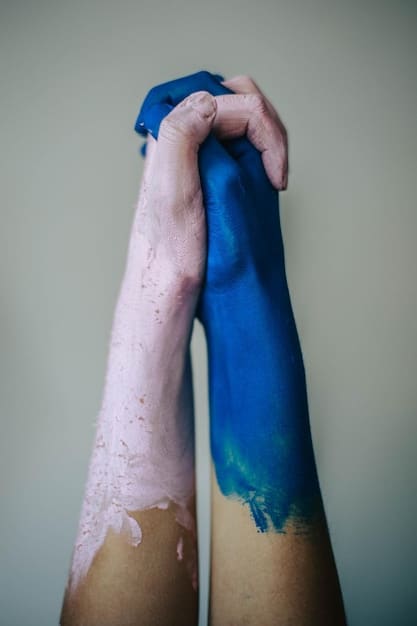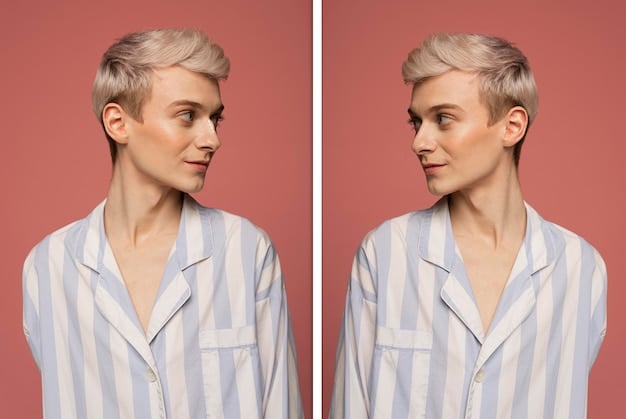The Power of Color: Choosing Clothes That Flatter Your Skin Tone in the US

Advertisements
Discover how to enhance your appearance by selecting clothing colors that harmonize with your skin tone, creating a flattering and confident look tailored to the US fashion landscape.
Want to know the secret to looking effortlessly put-together? It all comes down to understanding the power of color: how to choose clothing colors that flatter your skin tone in the US can transform your entire look, highlighting your best features and boosting your confidence.
Advertisements
Understanding Your Skin Tone
Identifying your skin tone is the first step in unlocking a more harmonious and flattering wardrobe. A well-chosen color palette can brighten your complexion, make your eyes sparkle, and minimize any perceived imperfections.
The Basics of Skin Tones
Skin tone refers to the surface color of your skin, while undertone is the subtle hue underneath. Skin tone can change due to sun exposure, but your undertone remains constant. Knowing your undertone helps you choose the most flattering colors.
Advertisements
Identifying Your Undertone
There are three main undertones: warm, cool, and neutral. Each undertone interacts differently with various colors, resulting in either a harmonious or a clashing effect. Here’s how to figure out yours:
- The Vein Test: Look at the veins on your wrist under natural light. Blue or purple veins typically indicate a cool undertone, while green veins suggest a warm undertone. If you can’t tell, you likely have a neutral undertone.
- The Jewelry Test: Consider whether you look better in gold or silver jewelry. Gold tends to complement warm undertones, while silver looks stunning on cool undertones.
- The Neutral Color Test: Observe how your skin looks against pure white versus off-white clothing. Cool undertones usually look better in pure white, while warm undertones are flattered by off-white.

Once you’ve determined your undertone, you can start exploring the colors that will enhance your natural beauty. The right colors can make you look healthier, more vibrant, and more confident.
Best Colors for Warm Undertones
If you have a warm undertone, think of the sun and earth – golden, yellow, and olive hues will likely look amazing on you. These colors bring out the natural warmth in your skin, creating a radiant and healthy glow.
Earthy Tones
Earthy tones like olive green, rust, and mustard yellow are excellent choices for warm undertones. These colors harmonize with the skin’s natural warmth, creating a grounded and sophisticated look.
Warm Neutrals
Instead of stark white and black, opt for warm neutrals like cream, beige, and camel. These softer shades provide a flattering contrast without washing out your complexion. Consider these options for your wardrobe basics:
- Cream-colored sweaters: A versatile piece that pairs well with almost anything.
- Beige trousers: A classic alternative to traditional gray or black pants.
- Camel coats: An elegant outerwear option for cooler months.
Jewel Tones
Rich jewel tones like emerald green, ruby red, and sapphire blue can also work well, but ensure they have a warm base. For example, opt for a warmer, more golden sapphire rather than a cool, icy blue.
Experiment with different shades within the warm color family to find the ones that make you feel most confident. Don’t be afraid to incorporate pops of color into your outfits to add visual interest and personality. Remember, fashion is about expressing yourself, so have fun with it!
Ideal Colors for Cool Undertones
If you have a cool undertone, you generally look best in colors inspired by the ocean and sky. Think blues, purples, and silvers, which complement the cooler tones in your skin and create a harmonious and elegant appearance.
Cool Blues and Greens
Shades like icy blue, seafoam green, and lavender are particularly flattering. These colors enhance the cool undertones in your skin, making you look fresh and vibrant. Explore incorporating these hues into your wardrobe:
- Icy blue blouses: A refreshing addition to your work wardrobe.
- Seafoam green dresses: Perfect for spring and summer occasions.
- Lavender sweaters: A soft and calming option for everyday wear.
Cool Neutrals
Opt for cool neutrals like bright white, gray, and navy. These shades provide a clean and sophisticated backdrop, allowing your natural coloring to shine. Consider building your wardrobe with these essentials:
Incorporating the right colors can truly transform your wardrobe and enhance your natural beauty. By understanding your skin tone and undertone, you can create a timeless and flattering style that reflects your personality and confidence.

Colors for Neutral Undertones
If you have a neutral undertone, you have the enviable ability to wear a wide range of colors. However, certain shades will enhance your complexion more than others. The key is to look for colors that are neither too warm nor too cool, striking a perfect balance.
Soft and Muted Colors
Soft, muted colors often work best for neutral undertones. These shades don’t overpower your natural coloring but instead enhance it subtly. Think of dusty rose, jade green, and soft peach.
Balanced Neutrals
Neutrals like light gray, taupe, and off-white are also excellent choices. These colors provide a versatile foundation for your wardrobe and can be easily paired with bolder hues. Remember to test how these neutrals look against your skin. What works for one person doesn’t always work for another:
- Light Gray: An ideal substitute to black and white, works perfectly in professional settings.
- Taupe: Can make the skin appear softer and add a touch of elegance.
- Off-White: A step down from pure white, avoiding harsh contrasts with skin.
Experiment with Colors
Feel free to experiment with both warm and cool colors to see what you prefer. Just be mindful of the intensity of the colors. For example, a muted olive green might work better than a bright Kelly green, and a dusty lavender might be more flattering than a vibrant purple.
Finding the perfect colors for your neutral undertone involves a bit of trial and error. Don’t be afraid to step outside your comfort zone and explore different shades. With a little experimentation, you’ll discover a palette that makes you look and feel your best. It’s fun to add your personality to the look.
Colors to Avoid Based on Your Skin Tone
While knowing what colors to embrace is important, understanding which ones to avoid can also make a significant difference in your overall appearance. Colors that clash with your skin tone can make you look washed out, tired, or even unwell.
For Warm Undertones
Avoid colors that are too cool and icy, such as icy blues, purples, and silvers. These shades can make your skin look sallow and drain your natural warmth. Also, steer clear of very bright, neon colors, as they can overpower your complexion.
- Icy Blues: Can wash out the natural warmth, making skin appear dull.
- Purples: May clash with the golden undertones, creating a disbalanced look.
For Cool Undertones
Avoid overly warm colors like oranges, yellows, and golds. These shades can make your skin look ruddy and highlight any redness. Also, be cautious with earth tones, as they can make your complexion appear dull and lifeless.
Finding the right colors for your wardrobe is a journey of self-discovery. Don’t be afraid to experiment and trust your instincts. After all, the most important thing is to wear what makes you feel confident and beautiful.
| Key Point | Brief Description |
|---|---|
| 🎨 Understanding Undertones | Determine if you have warm, cool, or neutral undertones to guide color choices. |
| ☀️ Colors for Warm Undertones | Earthy tones like olive green, rust, and warm neutrals such as cream and camel are ideal. |
| ❄️ Colors for Cool Undertones | Cool blues, greens, and neutrals like bright white and navy complement cool skin tones. |
| ⚖️ Colors for Neutral Undertones | Soft and muted colors such as dusty rose and light gray work well, offering balance. |
FAQ: Choosing Colors for Your Skin Tone in the US
How do I determine my skin’s undertone?
▼
You can determine your skin’s undertone by observing your veins (blue/purple = cool, green = warm) or by comparing how gold and silver jewelry look on your skin.
What colors are best for warm skin tones?
▼
Warm skin tones look best in earthy tones like olive green and rust, as well as warm neutrals like cream and camel.
What colors are ideal for cool skin tones?
▼
Cool skin tones are flattered by cool blues, greens, and neutrals like bright white, gray, and navy.
Can people with neutral skin tones wear any color?
▼
Yes, but they usually look best in soft, muted colors, as well as balanced neutrals like light gray and taupe.
What colors should I avoid based on my skin tone?
▼
Warm skin tones should avoid icy blues and purples, while cool skin tones should steer clear of oranges, yellows, and golds.
Conclusion
By understanding your skin tone and choosing colors that complement it, you can enhance your natural beauty and create a wardrobe that makes you look and feel your best. Experiment with different shades and trust your instincts to find what works for you, embracing fashion as a tool for self-expression and confidence.